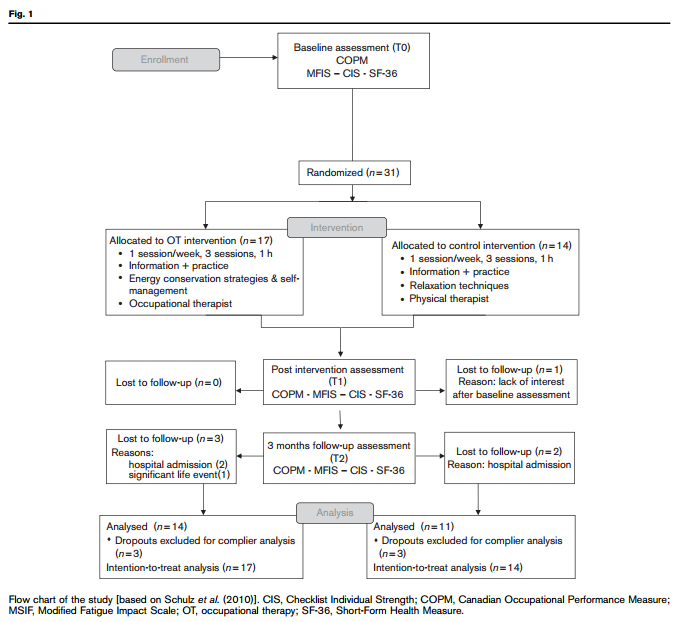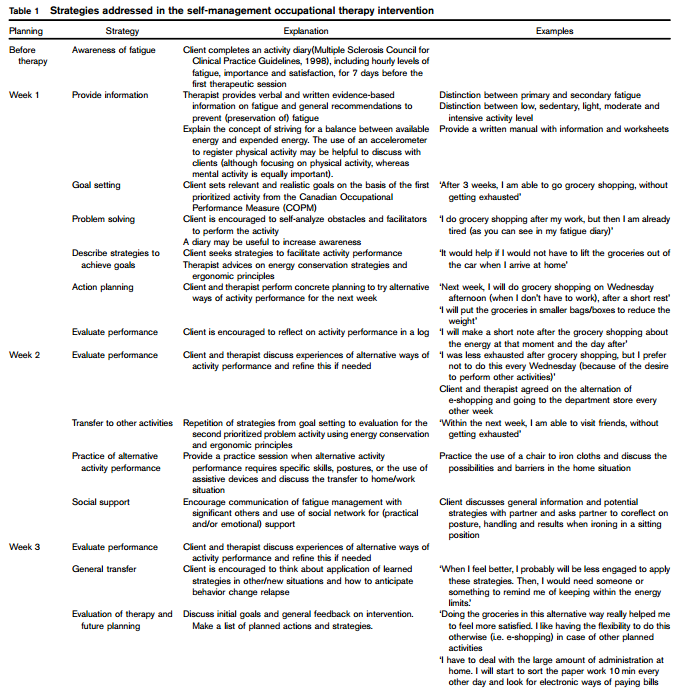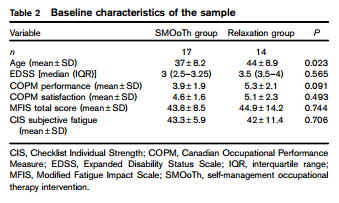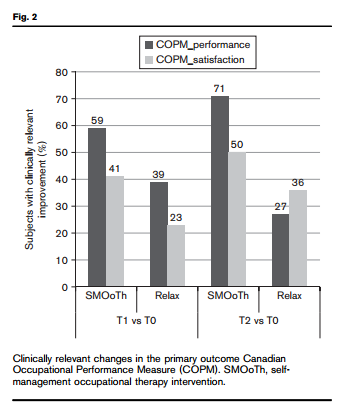The effectiveness of a self-management occupational therapy intervention
Why is this important to me?
Fatigue is one of the most common and disabling symptoms of MS. It can occur in as many as 50 to 92% of individuals with MS. A variety of strategies, including exercise and drug therapy, can help to manage fatigue. In this article, the authors compare the use of occupational therapy to relaxation therapy for managing fatigue.
What is the objective of this study?
This study, compared the effectiveness of two rehabilitation strategies on performance of and satisfaction with daily activities in people with MS who are experiencing fatigue. People with MS were randomly assigned to participate in one of the following two rehabilitation programs:
Self-management occupational therapy consisted of three 60- to 90-minute sessions over 3 weeks. This program was geared toward behavioral changes in which the participant learned to take control over his or her ability to perform daily activities according to available energy. The program was administered by an occupational therapist. Key steps in the program were:
Awareness of fatigue as recorded in a fatigue diary
- Delivery by the therapist of evidence-based information on fatigue and ways to prevent it, such as striving for a balance between available energy and energy expended
- Setting a goal. Example: going to the grocery store without becoming exhausted
- Problem solving to achieve a goal
- Action planning. Example: shopping on a day when the participant does not also have to work
- Evaluating the outcome and suggested alternatives. Example: e-shopping and home delivery
- Transferring successful concepts to other activities
- Requesting social support from a partner or caregiver
Relaxation Therapy was delivered by a physical therapist for the same amount of time as the occupational therapy intervention and involved:
- Education about the role of stress management in MS
- Practicing of relaxation methods
- Use of a stress-reaction diary that was used for subsequent coaching by the physical therapist
Results of this study showed:
- The perceived ability to perform activities and the participant’s satisfaction with activities, including those involving self-care, productivity, and leisure, increased in both groups immediately after the intervention and 3 months later, with no clear differences between interventions.
- Three months after completion of the rehabilitation program, 71% of occupational therapy participants showed improvement in performance of daily activities compared to 27% of relaxation participants.
- Both groups experienced improved social function and less physical pain over time, with the occupational therapy group reporting a greater reduction in physical pain.
Thus, both interventions improved performance of and satisfaction with the ability to perform everyday activities, and the effects were sustained for at least 3 months. The occupational therapy program provided better results in some respects.
These interventions were delivered to individual participants, allowed the therapist to deliver a customized approach. The impact of delivery of similar interventions in a group setting compared to in an individual setting remains to be explored. One advantage of group rehabilitation sessions is that they would allow participants to compare their behavior, strategies and results with the other individuals in their group.
How did the authors study this issue?
The authors performed a single-blind, randomized controlled trial in which 31 people with MS in Belgium were randomly assigned to receive the planned occupational therapy intervention (17 participants) or the relaxation intervention, which served as a control (14 participants).
Assessments were completed before the study began by blinded investigators (they did not know which intervention the participants received), immediately afterwards, and 3 months later. Participants were queried about their ability to perform activities and their satisfaction with these activities as well as the impact of fatigue on physical, cognitive, and psychosocial functioning, and quality of life.
| SHARE: | |||||
Original Article
The effectiveness of a self-management occupational therapy intervention on activity performance in individuals with multiple sclerosis-related fatigue: a randomized-controlled trial
International Journal of Rehabilitation Research
Kos, Daphne; Duportail, Marijke; Meirte, Jill; Meeus, Mira; D’hooghe, Marie B.; Nagels, Guy; Willekens, Barbara; Meurrens, Tom; Ilsbroukx, Stephan; Nijs, Jo
Introduction
Fatigue is one of the most common and bothersome symptoms in multiple sclerosis (MS) patients and is reported in 50–92% of the MS population (Wood et al., 2013; Patti and Vila, 2014). Possible strategies to deal with fatigue include exercise therapy, self-management, education, transcranial direct current stimulation, and pharmacological treatment (Asano et al., 2014; Ferrucci et al., 2014; Toosy et al., 2014). Pharmacological treatments are often unsatisfactory, whereas rehabilitation strategies seem to have better effects and should be the initial treatment (Asano and Finlayson, 2014).
Energy management (or energy conservation) is a wellknown strategy in fatigue rehabilitation for individuals with MS (Asano et al., 2014). The original 6-week groupbased program developed by Packer et al. (1995) includes teaching strategies to self-manage the challenges in daily life by prioritizing, balancing rest and activity, monitoring (extreme) fatigue levels, altering expectations, applying ergonomic principles, etc. Two meta-analyses provide evidence for energy management to be more effective than no treatment (wait list controls) in reducing the impact of fatigue and increasing quality of life (Blikman et al., 2013; Asano and Finlayson, 2014). All available evidence is based on a group format, which could bias the net effect of energy management (Blikman et al., 2013). Therefore, the aim of this study is to evaluate the effectiveness of an individual self-management occupational therapy intervention program (SMOoTh) versus relaxation on the performance of and satisfaction with relevant daily activities in patients with MS-related fatigue.
Methods
Sample
The study was approved by the ethical committees of the University Hospital of Antwerp and the National Multiple Sclerosis Center of Melsbroek and all participants signed an informed consent. The study protocol was registered at http://www.clinicaltrials.gov (identifier: NCT01512329).
Participants were recruited in the National Multiple Sclerosis Center Melsbroek and University Hospital Antwerp (Belgium) between 2011 and 2014. Eligibility was screened on the basis of the following criteria: definite diagnosis of MS confirmed by the neurologist, age between 18 and 65 years, Dutch speaking, ambulatory (expanded disability status scale of 5 or lower), and high impact of fatigue (visual analog scale score of at least 60) (Kos et al., 2006). Exclusion criteria were as follows: involved in a rehabilitation program during the study period, pregnancy, relapse 3 months before the study, or severe cognitive disorders (as judged by the neurologist).
Required sample size was calculated with the software G-power 3.1.7 (Universität Kiel, Kiel, Germany) using the change scores of the Canadian Occupational Performance Measure (COPM) (performance scale] in a pilot sample of patients with chronic fatigue syndrome (Faul et al., 2007; Nijs et al., 2009). With a significance level of 0.05 and a power of 0.8, the total sample size needed to be at least 20 patients to detect a clinically relevant change in COPM scores of 2 or more.
Procedure
In a single-blind randomized-controlled trial design, assessment was performed at baseline, after the intervention, and at the 3-month follow-up (Fig. 1). Selected potential participants were informed about the study by one of the researchers or study nurse by telephone and received a study leaflet. One week later, they were contacted to confirm willingness to participate. Informed consent was signed during their first visit before assessment.
All assessments were performed by a researcher blinded to treatment allocation. After the interview and scoring of the COPM, patients completed the questionnaires in a random order to account for test order bias. To prevent administration bias, participants performed self-report assessment without input or feedback from the researcher.
Patients were randomly allocated to the SMOoTh versus the relaxation group by blindly self-picking a folded paper out of a box and handing it over to an independent researcher (not involved in data collection or analyses). The latter informed patients about the type of intervention that they would receive. Patients were informed that both interventions could be helpful for improving fatigue and were therefore quasi-blinded for treatment effects.
Treating therapists were not involved in any of the assessment procedures.
Patients were asked not to change or initiate any new (pharmaceutical) interventions during the study period. Inevitable changes in medication were reported.

Intervention
Self-management occupational therapy
The SMOoTh program is based on the recommendations of the MS Council, principles described in the study by Packer et al. (1995) and the Energy Conservation/ Envelope Theory (Multiple Sclerosis Council for Clinical Practice Guidelines 1998; Jason et al., 2013). The intervention includes strategies to support clients in taking control over the performance of activities within the limits of their available energy and therefore increase their selfefficacy in managing fatigue (Lorig and Holman 2003). This process implies a behavioral change in clients and therefore the intervention also includes several techniques to support this behavioral change, for example, ‘goal setting’, ‘self-monitoring’, or ‘feedback’ (Michie et al., 2013).
The SMOoTH consists of three individual sessions of 60–90 min for 3 consecutive weeks and is provided by an experienced occupational therapist. Table 1 shows the structure and planning of the SMOoTH. The first session focuses on coaching the client how to balance daily activities within the limits of their available energy. Daily activities include all responsibilities and desired activities in terms of personal and child care, domestic care, productivity, and leisure. Prioritized problem activities were extracted from the COPM within baseline assessment.
To support education, participants received a booklet with evidence-based information on (possible factors influencing and maintaining) fatigue, strategies to cope with fatigue, and pace activities. For 7 consecutive days before the first session, participants registered hourly type of activity, level of fatigue, how important the activity is for the client, and how satisfied he or she is with actual performance in a fatigue diary (Multiple Sclerosis Council for Clinical Practice Guidelines, 1998). Diaries were discussed in treatment sessions to support self-awareness and self-efficacy in balancing activities.
Because of the tailor-made nature of the intervention, the description of the strategies and the examples provided in this table are not exhaustive. More information can be found in several sources (Packer et al., 1995; Multiple Sclerosis Council for Clinical Practice Guidelines, 1998; Mathiowetz et al., 2005; Ghahari et al., 2009; Finlayson et al., 2012).

Relaxation therapy
The relaxation program for this study includes education on the role of stress (management) in MS and practicing relaxation techniques such as Jacobson, Schultz, visualization, etc., pending their individual preferences (Lehrer, 1996). An experienced physical therapist conducted the program. All information was assembled in an evidence-based information booklet and participants completed a stress-reaction diary to register activities or events that induce stress. This diary was used to coach clients in improving coping with similar future stress events. The mode, duration, and frequency of the relaxation therapy were identical to the SMOoTh program.
Outcome measures
The COPM (primary outcome measure) assesses (changes in) the perceived ability to perform and satisfaction with relevant daily activities (Law et al., 2005). Using a semistructured interview, the therapist explores problems in performing relevant daily activities in the domains of self-care, productivity, and leisure. For performance and satisfaction subscales, the mean score for all activities is calculated (1–10). For follow-up assessment, COPM blind scores are used, that is, previous COPM scores on performance and satisfaction are made invisible to both the researcher and the participant (Eyssen et al., 2011). The COPM is a reliable, valid, and responsive instrument and change scores of 1.4 for performance and 1.9 for satisfaction are considered clinically important (Eyssen et al., 2005; Eyssen et al., 2011).
The Modified Fatigue Impact Scale (MFIS) assesses the impact of fatigue on physical, cognitive, and psychosocial functioning (range 0–84) (Multiple Sclerosis Council for Clinical Practice Guidelines 1998; Kos et al., 2003). The Modified Fatigue Impact Scale showed adequate reliability, validity, and responsiveness in MS samples (Kos et al., 2003; Rietberg et al., 2010; Learmonth et al., 2013).
The Checklist Individual Strength (CIS-20R) is a selfreport instrument to evaluate diverse aspects of fatigue (subjective experience of fatigue, reduction in concentration, motivation, and activity), and has acceptable reliability and validity (Vercoulen et al., 1999; Rietberg et al., 2010).
The Short-Form Health Measure (SF-36) assesses functional status and well-being, or quality of life, and has adequate reliability and validity in a wide variety of patient populations (McHorney et al., 1994).
Statistical analyses
Data were analyzed using SPSS, version 21.0 (SPSS Inc., Chicago, Illinois, USA). The Shapiro–Wilk normality test showed a normal distribution for all variables.
Parametric analyses include 2 (group: SMOoTh and relaxation)×3 (time: T0, T1 and T2) mixed model analysis of variance. Group is a between-patient factor and time is a within-patient factor. Both compliers and intention-to-treat (first observation carrier forward method) analyses were carried out. When differences between groups occur, effect sizes are expressed as Cohen’s d with a 95% confidence interval and considered small when d=0.20; moderate when d=0.50; and values of 0.80 and higher reflect large effect sizes.
The proportion of patients with a change score in COPM of at least 1.4 for performance and 1.9 for satisfaction was calculated to evaluate clinical relevance (Eyssen et al., 2011).
Statistical significance is considered with α = 0.05 and β= 0.20.
Results
The sample included 31 patients with MS (n= 17 intervention group and n= 14 control group) (Fig. 1). The mean age of the patients was 41 ± 9.2 years. The patients in the SMOoTh group were slightly younger, all other variables were similar in both groups (Table 2). Dropouts (18% in the SMOoTh group and 21% in the relaxation group) did not differ significantly from compliers for baseline variables and the dropout rate was similar in both groups.
In compliers, COPM performance and satisfaction scores changed significantly over time in both groups, without differences between groups (Table 3). SF-36 scores of ‘social functioning’ and ‘physical pain’ showed significant time effects; group effects were only found for the latter [effect size T1: 0.47 (−0.31 to 1.3); T2: 2.11 (0.73–2.55)]. Similar results were found in the intention-to-treat analyses.
Clinically relevant changes in occupational performance and satisfaction were more obvious in the SMOoTh group (Fig. 2). At 3 months of follow-up (T2), more than 70% of the patients in the SMOoTh group perceived better performance in desired activities, with a clinically relevant improved satisfaction score in 50% of cases.
None of the participants reported initiation or alteration of other treatments during the study period, except for two dropouts (who were admitted to hospital).

Discussion
The results of this pilot study suggest a beneficial effect of both an individual face-to-face self-management occupational therapy program and a relaxation program on the performance of and satisfaction with desired and important activities in daily life in patients with MSrelated fatigue. A total of 71% of the participants in the self-management group showed clinically relevant changes in COPM performance scores 3 months following the program compared with 27% of patients in the relaxation group.
The effect of relaxation is somewhat surprising, although explicable. Using stress management techniques, patients may also be more efficient in performing the scope of daily activities (Reynard et al., 2014). The positive trend toward favoring the SMOoTh may be explained by the more practical focus on managing problem activities. Stress management may be one of the approaches within the overall self-management of fatigue.
Self-management nor relaxation could reduce feelings of (the impact of) fatigue. This is the first study in MS using COPM as a (primary) outcome, but most of the energy conservation programs and relaxation techniques showed a reduction of fatigue (Dayapoğlu and Tan, 2012; Blikman et al., 2013). Energy conservation interventions all used a group format and were compared with wait list controls receiving no intervention. In MS, an individualized outpatient rehabilitation program including occupational therapy focusing on energy conservation did not show any changes in fatigue (impact) scores, which is in line with our findings (Rietberg et al., 2014). However, a similar individual program did show improvements both in COPM and in fatigue scores in patients with chronic fatigue syndrome (Kos et al., 2015). These results may suggest that group dynamics are highly important in reducing fatigue (impact) scores in patients with MS, but no studies have as yet compared individual and group approaches.
The self-management program is based on behavior change theories, focusing on alterations in daily life activity performance (values), prioritizing, task duration, alternation between physical and mental activity, etc. Several behavioral change techniques were used (Michie et al., 2013). Although the individual approach was very useful to set and review personal and relevant goals and tailor-made graded tasks, the technique ‘comparison of behavior’ with peers was not possible (Michie et al., 2013). Using filmed peer experiences or including one or more group sessions in the program would make it possible for participants to compare their behavior with others and share strategies. Earlier work showed a decrease in fatigue impact in a multidisciplinary group-based education program not particularly focusing on fatigue (as a placebo intervention) (Kos et al., 2007). Future work could study a combination of individual and group sessions to facilitate sharing information and experiences.
Participants of the self-management group showed a significant improvement in the SF-36 pain subscale. Although the intervention did not focus on pain management, a similar occupation-based self-management approach is used in patients with chronic pain (Robinson et al., 2011). Especially in chronic conditions, the concept of occupational value may play a central role in coping with consequences of the disease. Occupational value encompasses three components: concrete value (the visible outcome of an occupation: finished products, improved skills, or avoidance of negative consequences), symbolic value (the connotation of the occupation through which individuals can identify themselves within a subgroup, culture, or ideology), and self-reward value (immediate reward of performance an occupation: enjoyment, getting in a flow state) (Persson et al., 2001). Within an individual approach, occupational therapists may be able to optimize not only activity performance per se but also the perceived value of doing everyday activities (Larson and Von Eye, 2010; Wästberg et al., 2015).
Limitations
In addition to the study strengths (balanced treatment groups, blinded assessors, randomized design, and careful screening of eligible patients), some limitations require mentioning. The sample size was rather small, but fulfilled the requirements resulting from the a priori power calculation. This calculation was based on the primary outcome COPM, which may have resulted in an overestimation of the effect on secondary outcomes. Future studies with larger samples are needed to confirm the findings.
The self-management program was well tolerated in our sample. No adverse effects were reported and the dropout rate was rather limited. However, patients may have been highly motivated to participate in an intervention program because of the voluntary nature of recruitment. It is assumable that patients already entered the first stage(s) of behavioral change, facilitating actual (sustained) behavioral change (Prochaska and Velicer, 1997). The time since diagnosis within the sample was quite diverse (8.4 ± 5.2 years), which may imply distinct levels of coping with (consequences of) the disease and redesign of activities (Mikula et al., 2015). Conclusions may therefore not be valid for the entire MS population.
Although depression is common in patients with MS and correlates with fatigue, we did not screen for depression (Feinstein et al., 2014). We argue that, consistent with other studies, the behavioral approach provided here may also benefit depression, irrespective of the origin, and therefore we did not wish to exclude depressed patients (Heesen et al., 2012). To explore the net effects of the intervention(s) on primary fatigue, all potential causes of secondary fatigue should be excluded. However, it is still unclear how all factors interact in the origin and persistence of fatigue in MS. Future research with large sample sizes may be able to determine potential (combinations of) influences on the effects of behavioral interventions.
Participants needed to visit the center five times, which may have excluded those who are either not able to travel or were limited in spending time during office hours for this purpose. To deal with these barriers, the therapist may provide the program at home, which is additionally beneficial in the possibility to perform/train/advice activities in an authentic situation. Future research should evaluate the feasibility, effectiveness, and economic analysis of such a home-delivered intervention.
Conclusion
Both interventions seem to be feasible approaches to improve the performance of and satisfaction with desired daily activities in patients with MS, with a sustained effect after 3 months. A trend favoring the SMOoTh was observed. Neither program altered fatigue (impact) or quality of life, but the self-management program resulted in more clinically meaningful improvements in performance and satisfaction with desired daily activities. Future studies with larger sample sizes are needed to confirm the results.
Acknowledgements
The authors thank the students and staff who collaborated in the study and the participants for their willingness and time. Special thanks are due to Ann Vann Remoortel, who has enabled a timely selection of motivated candidates in the MS center Melsbroek. This work is supported by grant no. PWO G848 provided by the research council of Artesis Plantijn University College of Antwerp, Belgium and Koning Boudewijn Stichting Belgium (Fonds Claire Fauconnier).
Conflicts of interest
There are no conflicts of interest
References
Asano M, Berg E, Johnson K, Turpin M, Finlayson ML (2015). A scoping review of rehabilitation interventions that reduce fatigue among adults with multiple sclerosis. Disabil Rehabil 37:729–738.
Asano M, Finlayson ML (2014). Meta-analysis of three different types of fatigue management interventions for people with multiple sclerosis: exercise, education, and medication. Mult Scler Int 2014:798285.
Blikman LJ, Huisstede BM, Kooijmans H, Stam HJ, Bussmann JB, van Meeteren J (2013). Effectiveness of energy conservation treatment in reducing fatigue in multiple sclerosis: a systematic review and meta-analysis. Arch Phys Med Rehabil 94:1360–1376.
Dayapoğlu N, Tan M (2012). Evaluation of the effect of progressive relaxation exercises on fatigue and sleep quality in patients with multiple sclerosis. J Altern Complement Med 18:983–987.
Eyssen IC, Beelen A, Dedding C, Cardol M, Dekker J (2005). The reproducibility of the Canadian occupational performance measure. Clin Rehabil 19:888–894.
Eyssen IC, Steultjens MP, Oud TA, Bolt EM, Maasdam A, Dekker J (2011). Responsiveness of the Canadian occupational performance measure. J Rehabil Res Dev 48:517–528. Faul F,
Erdfelder E, Lang AG, Buchner A (2007). G*Power 3: a flexible statistical power analysis program for the social, behavioral, and biomedical sciences. Behav Res Methods 39:175–191.
Feinstein A, Magalhaes S, Richard JF, Audet B, Moore C (2014). The link between multiple sclerosis and depression. Nat Rev Neurol 10:507–517.
Ferrucci R, Vergari M, Cogiamanian F, Bocci T, Ciocca M, Tomasini E, et al. (2014). Transcranial direct current stimulation (tDCS) for fatigue in multiple sclerosis. NeuroRehabilitation 34:121–127
Finlayson M, Sverker J, Kos D (2012). Rehabilitation for fatigue in multiple sclerosis. In: Finlayson M, editor. Multiple sclerosis rehabilitation: from impairment to participation. Chicago, IL: CRC Press.
Ghahari S, Packer TL, Passmore AE (2009). Development, standardisation and pilot testing of an online fatigue self-management program. Disabil Rehabil 31:1762–1772.
Heesen C, Köpke S, Kasper J, Poettgen J, Tallner A, Mohr DC, Gold SM (2012). Behavioral interventions in multiple sclerosis: a biopsychosocial perspective. Expert Rev Neurother 12:1089–1100.
Jason LA, Brown M, Brown A, Evans M, Flores S, Grant-Holler E, Sunnquist M (2013). Energy conservation/envelope theory interventions to help patients with myalgic encephalomyelitis/chronic fatigue syndrome. Fatigue 1:27–42.
Kos D, Kerckhofs E, Nagels G, D'Hooghe BD, Duquet W, Duportail M, Ketelaer P (2003). Assessing fatigue in multiple sclerosis: Dutch modified fatigue impact scale. Acta Neurol Belg 103:185–191.
Kos D, Nagels G, D’Hooghe MB, Duportail M, Kerckhofs E (2006). A rapid screening tool for fatigue impact in multiple sclerosis. BMC Neurol 6:27.
Kos D, Duportail M, D'hooghe M, Nagels G, Kerckhofs E (2007). Multidisciplinary fatigue management programme in multiple sclerosis: a randomized clinical trial. Mult Scler 13:996–1003.
Kos D, van Eupen I, Meirte J, van Cauwenbergh D, Moorkens G, Meeus M, Nijs J (2015). Activity pacing self-management in chronic fatigue syndrome: a randomized controlled trial. Am J Occup Ther 69:6905290020.
Larson E, von Eye A (2010). Beyond flow: temporality and participation in everyday activities. Am J Occup Ther 64:152–163.
Law M, Baptiste S, McColl M, Carswell A, Polatajko H, Pollock N (2005). Canadian occupational performance measure manual. 4th ed. Toronto, ON: CAOT.
Learmonth YC, Dlugonski D, Pilutti LA, Sandroff BM, Klaren R, Motl RW (2013). Psychometric properties of the fatigue severity scale and the modified fatigue impact scale. J Neurol Sci 331 (1–2):102–107.
Lehrer P (1996). Varieties of relaxation methods and their unique effects. Int J Stress Manag 3:1–15.
Lorig KR, Holman H (2003). Self-management education: history, definition, outcomes, and mechanisms. Ann Behav Med 26:1–7.
Mathiowetz VG, Finlayson KM, Matuska KM, Chen HY, Luo P (2005). Randomized controlled trial of an energy conservation course for persons with multiple sclerosis. Mult Scler 11:592–601.
McHorney CA, Ware JE Jr, Lu JF, Sherbourne CD (1994). The MOS 36-item short-form health survey (SF-36): III. Tests of data quality, scaling assumptions, and reliability across diverse patient groups. Med Care 32:40–66.
Michie S, Richardson M, Johnston M, Abraham C, Francis J, Hardeman W, et al. (2013). The behavior change technique taxonomy (v1) of 93 hierarchically clustered techniques: building an international consensus for the reporting of behavior change interventions. Ann Behav Med 46:81–95
Mikula P, Nagyova I, Krokavcova M, Vitkova M, Rosenberger J, Szilasiova J, et al. (2015). The mediating effect of coping on the association between fatigue and quality of life in patients with multiple sclerosis. Psychol Health Med 20:653–661.
Multiple Sclerosis Council for Clinical Practice Guidelines (1998). Fatigue and multiple sclerosis: evidence-based management strategies for fatigue in multiple sclerosis. Washington: Paralyzed Veterans of America.
Nijs J, van Eupen I, Vandecauter J, Augustinus E, Bleyen G, Moorkens G, Meeus M (2009). Can pacing self-management alter physical behavior and symptom severity in chronic fatigue syndrome? A case series. J Rehabil Res Dev 46:985–996.
Packer T, Brink N, Sauriol A (1995). Managing fatigue: a six-week course for energy conservation. Tucson, Arizona: Therapy Skill Builders.
Patti F, Vila C (2014). Symptoms, prevalence and impact of multiple sclerosis in younger patients: a multinational survey. Neuroepidemiology 42:211–218.
Persson D, Erlandsson LK, Eklund M, Iwarssona S (2001). Value dimensions, meaning, and complexity in human occupation: a tentative structure for analysis. Scand J Occup Ther 8:7–18.
Prochaska JO, Velicer WF (1997). The transtheoretical model of health behavior change. Am J Health Promot 12:38–48.
Reynard AK, Sullivan AB, Rae-Grant A (2014). A systematic review of stressmanagement interventions for multiple sclerosis patients. Int J MS Care 16:140–144.
Rietberg MB, van Wegen EE, Kwakkel G (2010). Measuring fatigue in patients with multiple sclerosis: reproducibility, responsiveness and concurrent validity of three Dutch self-report questionnaires. Disabil Rehabil 32:1870–1876.
Rietberg MB, van Wegen EE, Eyssen IC, Kwakkel G, MS study group (2014). Effects of multidisciplinary rehabilitation on chronic fatigue in multiple sclerosis: a randomized controlled trial. PLoS One 9:e107710.
Robinson K, Kennedy N, Harmon D (2011). Is occupational therapy adequately meeting the needs of people with chronic pain? Am J Occup Ther 65:106–113.
Schulz KF, Altman DG, Moher D, CONSORT Group (2010). CONSORT 2010 Statement: updated guidelines for reporting parallel group randomised trials. BMJ 340:c332.
Toosy A, Ciccarelli O, Thompson A (2014). Symptomatic treatment and management of multiple sclerosis. Handb Clin Neurol 122:513–562.
Vercoulen J, Alberts M, Bleijenberg G (1999). [The checklist individual strength (CIS)] De checklist individual strength (CIS). Gedragstherapie 32:131–136.
Wästberg Ba, Erlandsson L-K, Eklund M (2015). Women’s perceived work environment after stress-related rehabilitation: experiences from the ReDO project. Disabil Rehabil 8288:1–7.
Wood B, van der Mei IA, Ponsonby AL, Pittas F, Quinn S, Dwyer T, et al. (2013). Prevalence and concurrence of anxiety, depression and fatigue over time in multiple sclerosis. Mult Scler 19:217–224.
